Interplay between Discrete Emotions and Preventive Behavior in Health Crises: Big Data Analysis of COVID-19
Abstract
1. Introduction
2. Relevant Theory and Literature
2.1. ATF
2.2. The Effect of Discrete Emotions on Decision Making during a Crisis
3. Materials and Methods
3.1. Data Sources
3.1.1. Social Media Data
3.1.2. Google Shopping Trends Data
3.2. Methods
3.2.1. LIWC
3.2.2. Granger Causality Analysis and IRFs
4. Results
4.1. Descriptive Statistics of the Data
4.2. Granger Causality between Discrete Emotions and Preventive Behavior
4.3. The IRFs Results
4.3.1. The Impact of Discrete Emotion Shocks on Preventive Behavior
4.3.2. The Impact of Preventive Behavior Shocks on Discrete Emotions
5. Discussion
5.1. The Effects of Discrete Emotions on Preventive Behavior
5.2. The Effects of Preventive Behavior on Discrete Emotions
5.3. Limitations and Future Work
6. Conclusions
Funding
Institutional Review Board Statement
Informed Consent Statement
Data Availability Statement
Conflicts of Interest
References
- Dyer, J.; Kolic, B. Public risk perception and emotion on Twitter during the Covid-19 pandemic. Appl. Netw. Sci. 2020, 5, 1–32. [Google Scholar] [CrossRef] [PubMed]
- Breza, E.; Stanford, F.C.; Alsan, M.; Alsan, B.; Banerjee, A.; Chandrasekhar, A.G.; Eichmeyer, S.; Glushko, T.; Goldsmith-Pinkham, P.; Holland, K. Effects of a large-scale social media advertising campaign on holiday travel and COVID-19 infections: A cluster randomized controlled trial. Nat. Med. 2021, 27, 1622–1628. [Google Scholar] [CrossRef]
- Moon, W.-K.; Atkinson, L.; Kahlor, L.A.; Yun, C.; Son, H. US political partisanship and COVID-19: Risk information seeking and prevention behaviors. Health Commun. 2022, 37, 1671–1681. [Google Scholar] [CrossRef]
- Coifman, K.G.; Disabato, D.J.; Aurora, P.; Seah, T.S.; Mitchell, B.; Simonovic, N.; Foust, J.L.; Sidney, P.G.; Thompson, C.A.; Taber, J.M. What drives preventive health behavior during a global pandemic? Emotion and worry. Ann. Behav. Med. 2021, 55, 791–804. [Google Scholar] [CrossRef]
- Consedine, N.S.; Moskowitz, J.T. The role of discrete emotions in health outcomes: A critical review. Appl. Prev. Psychol. 2007, 12, 59–75. [Google Scholar] [CrossRef]
- Lerner, J.S.; Keltner, D. Fear, anger, and risk. J. Pers. Soc. Psychol. 2001, 81, 146. [Google Scholar] [CrossRef]
- Lerner, J.S.; Keltner, D. Beyond valence: Toward a model of emotion-specific influences on judgement and choice. Cogn. Emot. 2000, 14, 473–493. [Google Scholar] [CrossRef]
- Slovic, P.; Finucane, M.L.; Peters, E.; MacGregor, D.G. Risk as analysis and risk as feelings: Some thoughts about affect, reason, risk, and rationality. Risk. Anal. 2004, 24, 311–322. [Google Scholar] [CrossRef]
- Wang, Y.; Taylor, J.E. Coupling sentiment and human mobility in natural disasters: A Twitter-based study of the 2014 South Napa Earthquake. Nat. Hazards 2018, 92, 907–925. [Google Scholar] [CrossRef]
- Himelboim, I.; Sweetser, K.D.; Tinkham, S.F.; Cameron, K.; Danelo, M.; West, K. Valence-based homophily on Twitter: Network analysis of emotions and political talk in the 2012 presidential election. New Media Soc. 2016, 18, 1382–1400. [Google Scholar] [CrossRef]
- Lerner, J.S.; Li, Y.; Valdesolo, P.; Kassam, K.S. Emotion and Decision Making. Annu. Rev. Psychol. 2015, 66, 799. [Google Scholar] [CrossRef] [PubMed]
- Lerner, J.S.; Gonzalez, R.M.; Small, D.A.; Fischhoff, B. Effects of fear and anger on perceived risks of terrorism: A national field experiment. Psychol. Sci. 2003, 14, 144–150. [Google Scholar] [CrossRef] [PubMed]
- Han, S.; Lerner, J.S.; Keltner, D. Feelings and consumer decision making: The appraisal-tendency framework. J. Consum. Psychol. 2007, 17, 158–168. [Google Scholar] [CrossRef]
- Raghunathan, R.; Pham, M.T. All negative moods are not equal: Motivational influences of anxiety and sadness on decision making. Organ. Behav. Hum. Decis. Process. 1999, 79, 56–77. [Google Scholar] [CrossRef]
- Oh, S.H.; Lee, S.Y.; Han, C. The Effects of Social Media Use on Preventive Behaviors during Infectious Disease Outbreaks: The Mediating Role of Self-relevant Emotions and Public Risk Perception. Health Commun. 2021, 36, 972–981. [Google Scholar] [CrossRef]
- Yıldırım, M.; Geçer, E.; Akgül, Ö. The impacts of vulnerability, perceived risk, and fear on preventive behaviours against COVID-19. Psychol. Health. Med. 2021, 26, 35–43. [Google Scholar] [CrossRef] [PubMed]
- Sheek-Hussein, M.; Abu-Zidan, F.M.; Stip, E. Disaster management of the psychological impact of the COVID-19 pandemic. Int. J. Emerg. Med. 2021, 14, 1–10. [Google Scholar] [CrossRef]
- Esterwood, E.; Saeed, S.A. Past epidemics, natural disasters, COVID19, and mental health: Learning from history as we deal with the present and prepare for the future. Psychiatr. Q. 2020, 91, 1121–1133. [Google Scholar] [CrossRef] [PubMed]
- Merchán-Sanmartín, B.; Brocel-Bajaña, M.; Pambabay-Calero, J.; Bauz-Olvera, S.; Montalván-Burbano, N.; Aguilar-Aguilar, M.; Carrión-Mero, P. Multivariate analysis on physical activity, emotional and health status of university students caused by COVID-19 confinement. Int. J. Environ. Res. Public Health 2022, 19, 11016. [Google Scholar] [CrossRef]
- Turner, M.M.; Underhill, J.C. Motivating emergency preparedness behaviors: The differential effects of guilt appeals and actually anticipating guilty feelings. Commun. Q. 2012, 60, 545–559. [Google Scholar] [CrossRef]
- Kim, H.M.; Saffer, A.J.; Liu, W.; Sun, J.; Li, Y.; Zhen, L.; Yang, A. How public health agencies break through COVID-19 conversations: A strategic network approach to public engagement. Health Commun. 2022, 37, 1276–1284. [Google Scholar] [CrossRef]
- Phengsuwan, J.; Shah, T.; Thekkummal, N.B.; Wen, Z.Y.; Sun, R.; Pullarkatt, D.; Thirugnanam, H.; Ramesh, M.V.; Morgan, G.; James, P.; et al. Use of Social Media Data in Disaster Management: A Survey. Future Internet 2021, 13, 46. [Google Scholar] [CrossRef]
- Clore, G.L.; Bar Anan, Y. Affect as information. In Handbook of Affect and Social Cognition; Lawrence Erlbaum Associates: Mahwah, NJ, USA, 2007; pp. 121–144. [Google Scholar]
- Slovic, P.; Finucane, M.L.; Peters, E.; MacGregor, D.G. The affect heuristic. Eur. J. Oper. Res. 2007, 177, 1333–1352. [Google Scholar] [CrossRef]
- Zeelenberg, M.; Pieters, R. Beyond valence in customer dissatisfaction: A review and new findings on behavioral responses to regret and disappointment in failed services. J. Bus. Res. 2004, 57, 445–455. [Google Scholar] [CrossRef]
- Lu, J.; Xie, X.; Zhang, R. Focusing on appraisals: How and why anger and fear influence driving risk perception. J. Safety Res. 2013, 45, 65–73. [Google Scholar] [CrossRef]
- Yang, J.Z.; Chu, H. Who is afraid of the Ebola outbreak? The influence of discrete emotions on risk perception. J. Risk Res. 2018, 21, 834–853. [Google Scholar] [CrossRef]
- Keller, C.; Bostrom, A.; Kuttschreuter, M.; Savadori, L.; Spence, A.; White, M. Bringing appraisal theory to environmental risk perception: A review of conceptual approaches of the past 40 years and suggestions for future research. J. Risk Res. 2012, 15, 237–256. [Google Scholar] [CrossRef]
- Liu, Y.; Duong, H.T.; Nguyen, H.T. Media exposure and intentions to wear face masks in the early stages of the COVID-19 outbreak: The mediating role of negative emotions and risk perception. Atl. J. Commun. 2021, 30, 467–480. [Google Scholar] [CrossRef]
- Rosenboim, M.; Benzion, U.; Shahrabani, S.; Shavit, T. Emotions, risk perceptions, and precautionary behavior under the threat of terror attacks: A field study among Israeli college students. J. Behav. Decis. Mak. 2012, 25, 248–256. [Google Scholar] [CrossRef]
- Foo, M.D. Emotions and entrepreneurial opportunity evaluation. Entrep. Theory Pract. 2011, 35, 375–393. [Google Scholar] [CrossRef]
- Lerner, J.S.; Tiedens, L.Z. Portrait of the angry decision maker: How appraisal tendencies shape anger’s influence on cognition. J. Behav. Decis. Mak. 2006, 19, 115–137. [Google Scholar] [CrossRef]
- Horberg, E.J.; Oveis, C.; Keltner, D. Emotions as moral amplifiers: An appraisal tendency approach to the influences of distinct emotions upon moral judgment. Emot. Rev. 2011, 3, 237–244. [Google Scholar] [CrossRef]
- Septianto, F.; Tjiptono, F.; Arli, D.; Sun, J.-M. The differential effects of integral pride and gratitude on divergent moral judgment for the self versus others. Aust. J. Manag. 2022, 47, 579–594. [Google Scholar] [CrossRef]
- Lerner, J.S.; Small, D.A.; Loewenstein, G. Heart strings and purse strings: Carryover effects of emotions on economic decisions. Psychol. Sci. 2004, 15, 337–341. [Google Scholar] [CrossRef] [PubMed]
- Lim, J.R.; Liu, B.F.; Egnoto, M.; Roberts, H.A. Individuals’ religiosity and emotional coping in response to disasters. J. Cont. Crisis Manag. 2019, 27, 331–345. [Google Scholar] [CrossRef]
- So, J.; Kuang, K.; Cho, H. Reexamining fear appeal models from cognitive appraisal theory and functional emotion theory perspectives. Commun. Monogr. 2016, 83, 120–144. [Google Scholar] [CrossRef]
- Lazarus, R.S. Emotion and Adaptation; Oxford University Press: New York, NY, USA, 1991. [Google Scholar]
- Banda, J.M.; Tekumalla, R.; Wang, G.; Yu, J.; Liu, T.; Ding, Y.; Artemova, E.; Tutubalina, E.; Chowell, G. A large-scale COVID-19 Twitter chatter dataset for open scientific research—An international collaboration. Epidemiologia 2021, 2, 315–324. [Google Scholar] [CrossRef] [PubMed]
- Slovic, P. If I look at the mass I will never act: Psychic numbing and genocide. In Emotions and Risky Technologies; Springer: Berlin/Heidelberg, Germany, 2010; pp. 37–59. [Google Scholar]
- Lifton, R.J. Beyond psychic numbing: A call to awareness. Am. J. Orthopsychiatry 1982, 52, 619. [Google Scholar] [CrossRef]
- Hydrator [Computer Software]. Available online: https://github.com/docnow/hydrator (accessed on 12 October 2021).
- Hou, Z.Y.; Du, F.X.; Zhou, X.Y.; Jiang, H.; Martin, S.; Larson, H.D.; Lin, L. Cross-Country Comparison of Public Awareness, Rumors, and Behavioral Responses to the COVID-19 Epidemic: Infodemiology Study. J. Med. Internet Res. 2020, 22, e21143. [Google Scholar] [CrossRef]
- Arora, V.S.; Mckee, M.M.; Stuckler, D. Google Trends: Opportunities and limitations in health and health policy research. Health Pol. 2019, 123, 338–341. [Google Scholar] [CrossRef]
- de Francisco Carvalho, L.; Pianowski, G. Pathological personality traits assessment using Facebook: Systematic review and meta-analyses. Comput. Human Behav. 2017, 71, 307–317. [Google Scholar] [CrossRef]
- Pennebaker, J.W.; Mehl, M.R.; Niederhoffer, K.G. Psychological aspects of natural language use: Our words, our selves. Annu. Rev. Psychol. 2003, 54, 547–577. [Google Scholar] [CrossRef]
- Tausczik, Y.R.; Pennebaker, J.W. The psychological meaning of words: LIWC and computerized text analysis methods. J. Lang. Soc. Psychol. 2010, 29, 24–54. [Google Scholar] [CrossRef]
- Aiello, L.M.; Quercia, D.; Zhou, K.; Constantinides, M.; Šćepanović, S.; Joglekar, S. How epidemic psychology works on Twitter: Evolution of responses to the COVID-19 pandemic in the US. Humanit. Soc. Sci. Commun. 2021, 8, 1–15. [Google Scholar] [CrossRef]
- Xu, L.W.; Qiu, J.N.; Gu, W.J.; Ge, Y.D. The Dynamic Effects of Perceptions of Dread Risk and Unknown Risk on SNS Sharing Behavior During EID Events: Do Crisis Stages Matter? J. Assoc. Inf. Syst. 2020, 21, 545–573. [Google Scholar]
- Peters, E.M.; Burraston, B.; Mertz, C. An emotion-based model of risk perception and stigma susceptibility: Cognitive appraisals of emotion, affective reactivity, worldviews, and risk perceptions in the generation of technological stigma. Risk Anal. 2004, 24, 1349–1367. [Google Scholar] [CrossRef]
- Van Deursen, A.; van Dijk, J. The first-level digital divide shifts from inequalities in physical access to inequalities in material access. New Media Soc. 2019, 21, 354–375. [Google Scholar] [CrossRef]
- Deursen, A.J.A.M.; Helsper, E.; Eynon, R.; Van Dijk, J.A.G.M. The Compoundness and Sequentiality of Digital Inequality. Int. J. Commun. 2017, 11, 452–473. [Google Scholar]
- Park, S. Digital inequalities in rural Australia: A double jeopardy of remoteness and social exclusion. J. Rural. Stud. 2017, 54, 399–407. [Google Scholar] [CrossRef]
- Fan, C.; Esparza, M.; Dargin, J.; Wu, F.; Oztekin, B.; Mostafavi, A. Spatial biases in crowdsourced data: Social media content attention concentrates on populous areas in disasters. Comput. Environ. Urban Syst. 2020, 83, 101514. [Google Scholar] [CrossRef]
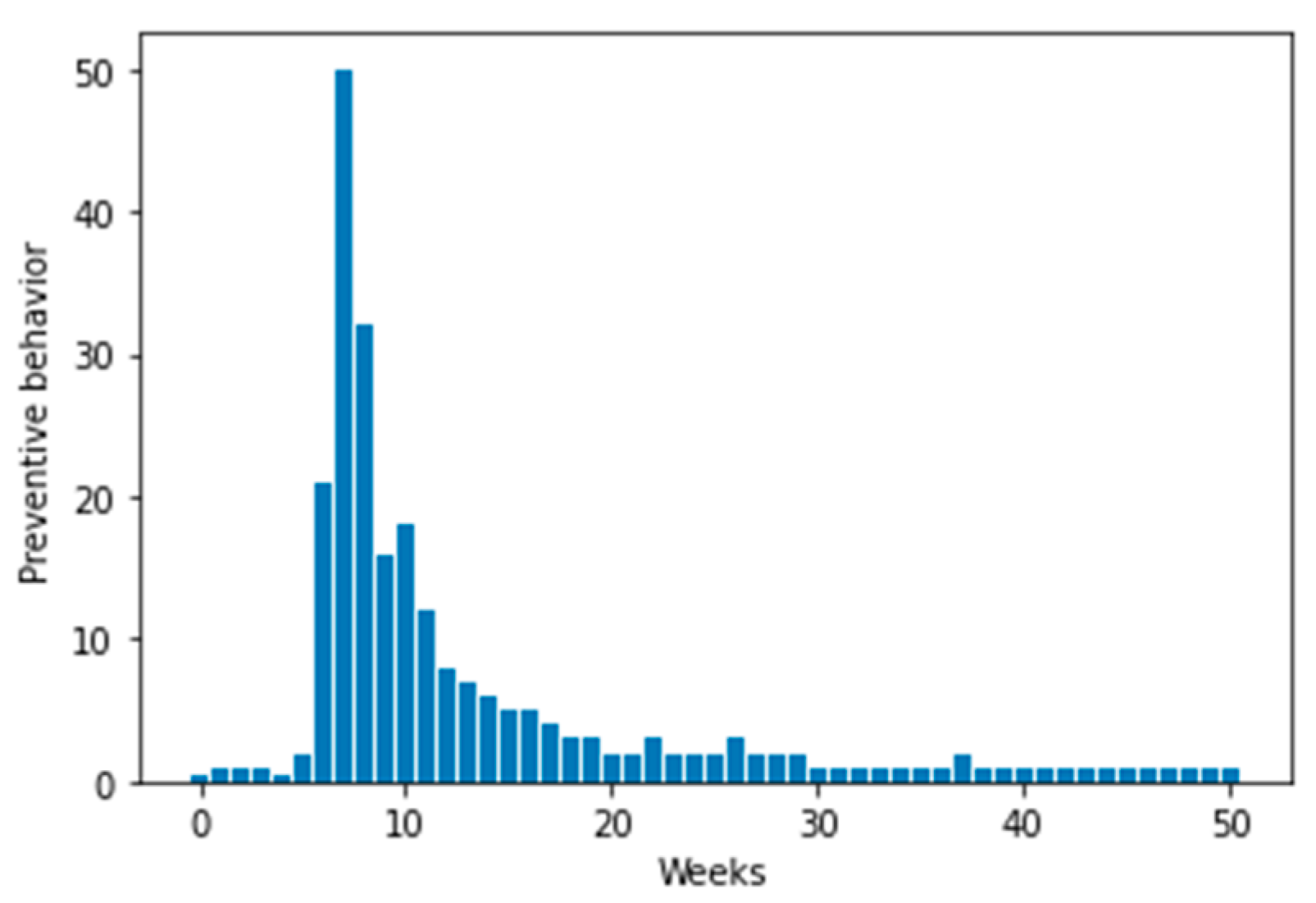
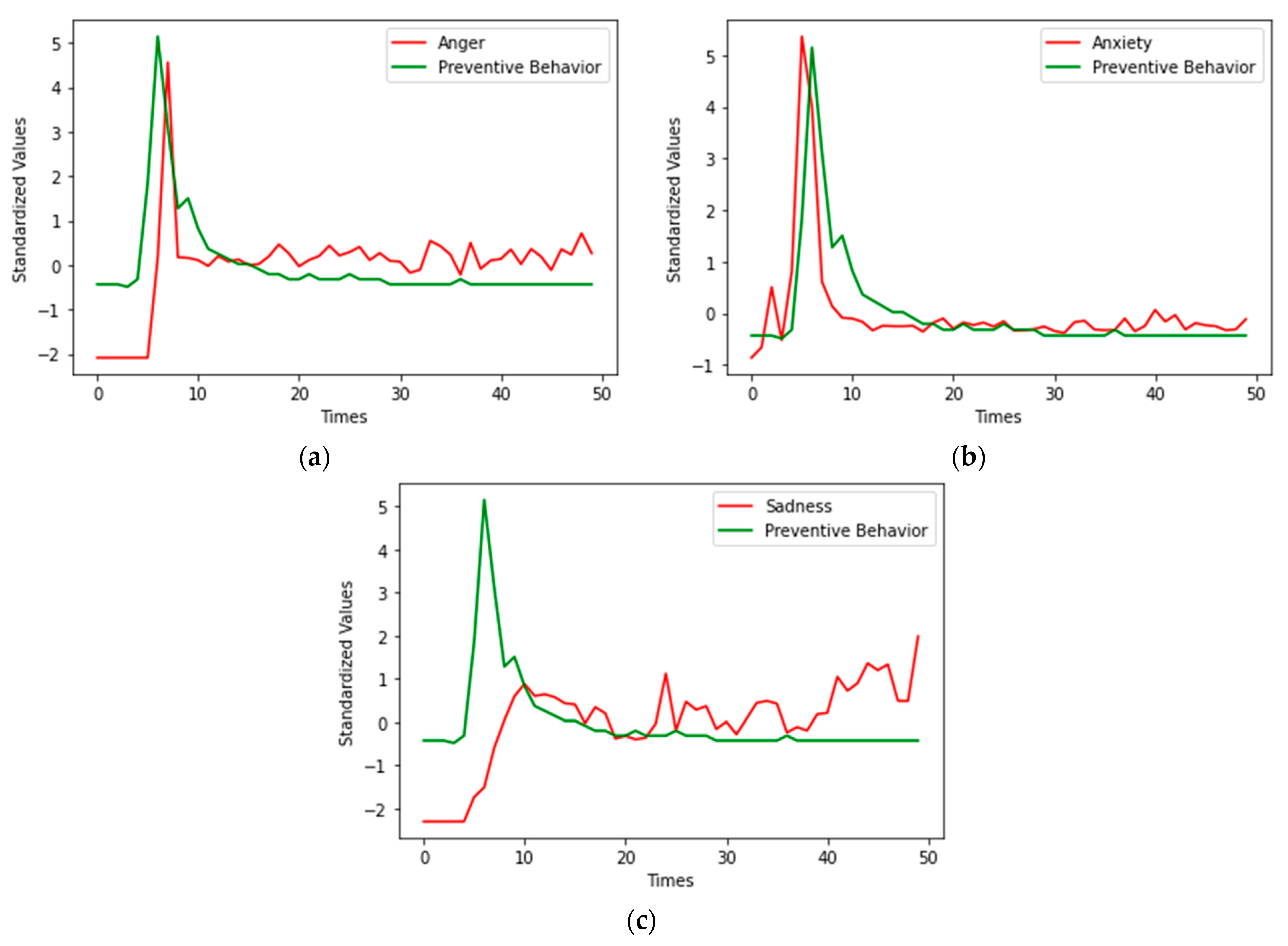
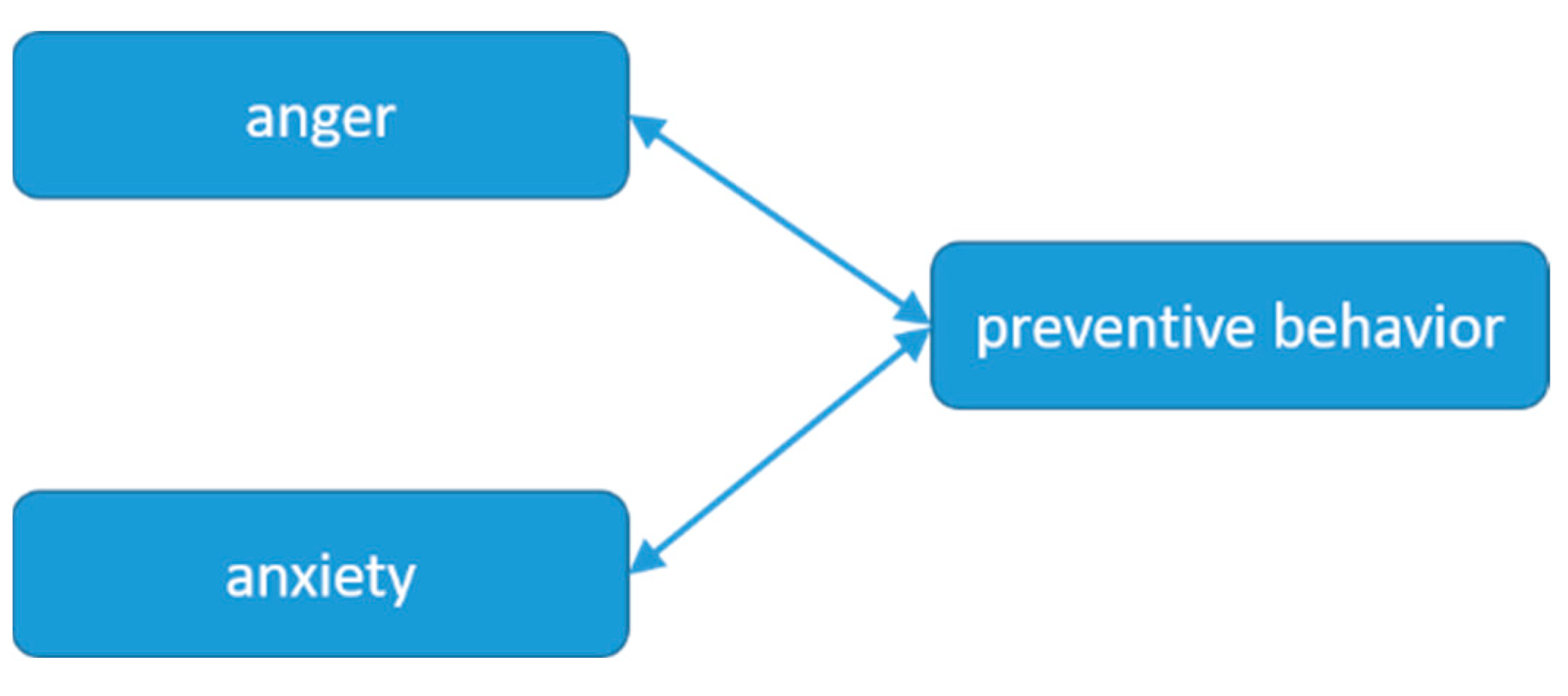
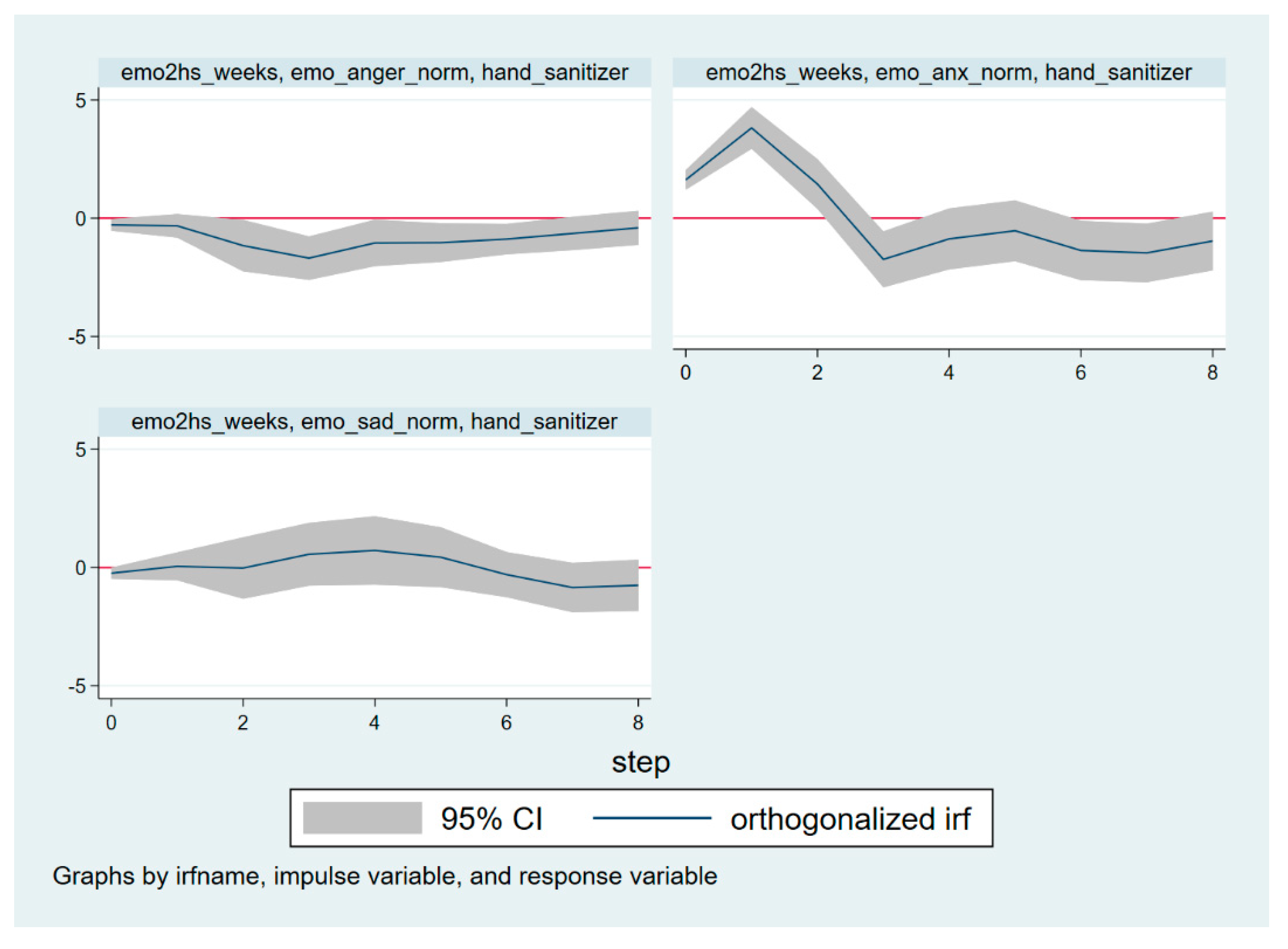
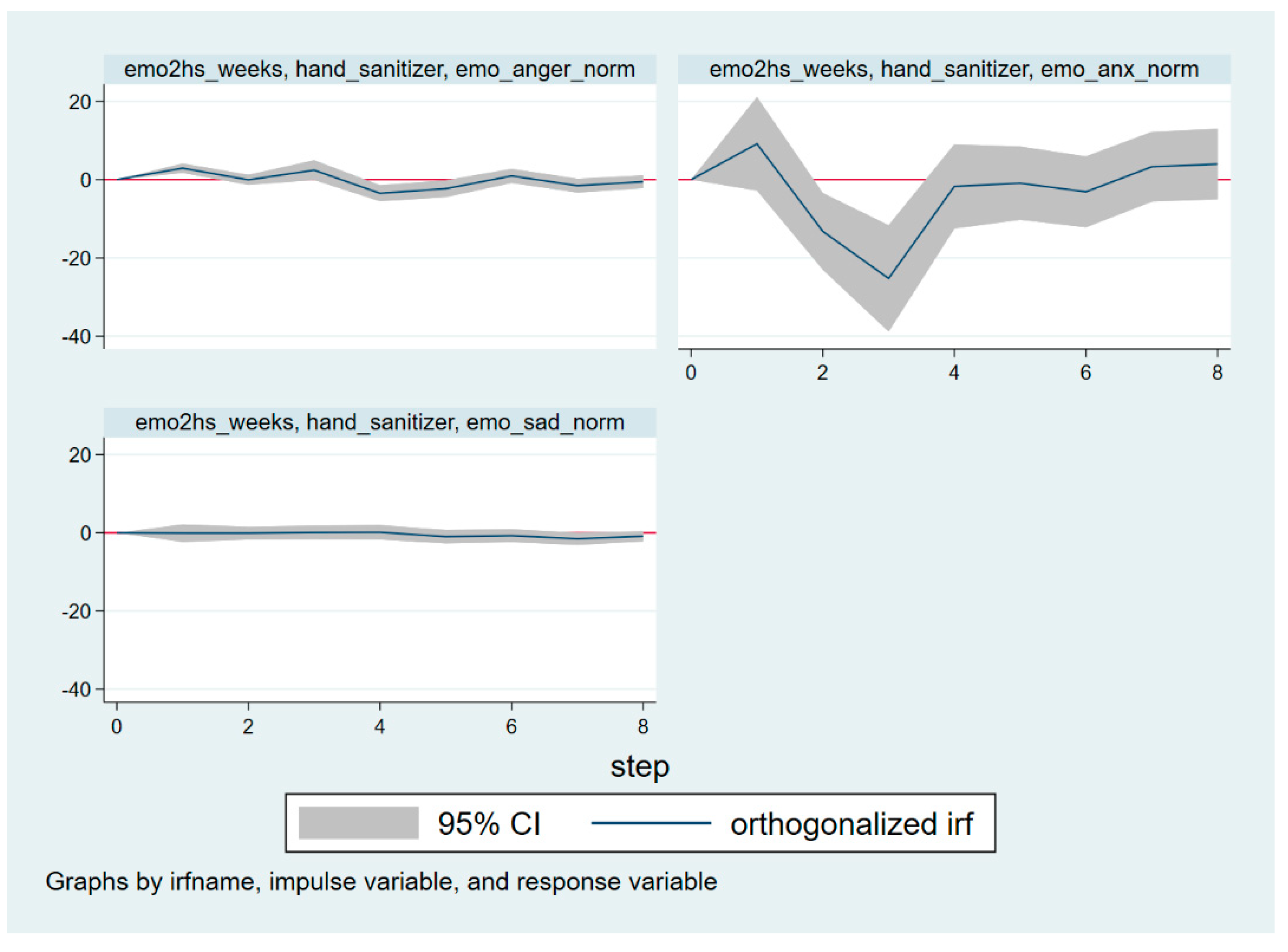
| Discrete Emotion | Positive Effect | Negative Effect | Reference |
|---|---|---|---|
| Fear | True | [27,29,30,36] | |
| Anxiety | True | [27,29,37] | |
| Anger | True | [6,7,29] | |
| Anger | True | [15,27] | |
| Disgust | True | [27] | |
| Sadness | True | [27] |
| No. | Tweet Text | Discrete Emotion |
|---|---|---|
| 1 | COVID-19 is starting to piss me off | Anger |
| 2 | Hate, hate, hate, double hate, LOATHE ENTIRELY | Anger |
| 3 | Fear. Fear. Fear. #COVID19 | Anxiety |
| 4 | I’m stressed and overwhelmed #COVID19 | Anxiety |
| 5 | Cry cry cry | Sadness |
| 6 | uhhhhhhhh ohhhhh :( :( :( :( #COVID19 | Sadness |
| Emotion | Minimum Value | Maximum Value | Mean | Standard Deviation |
|---|---|---|---|---|
| Anger | 0.00 | 42.86 | 0.08 | 0.76 |
| Anxiety | 0.00 | 75.00 | 0.12 | 0.86 |
| Sadness | 0.00 | 50.00 | 0.11 | 0.93 |
| Variable | Definition |
|---|---|
| Preventive behavior, expressed by Google Shopping Index within time window | |
| The index of anger within time window | |
| The index of anxiety within time window | |
| The index of sadness within time window |
| Emotion | Correlation Coefficient | p-Value |
|---|---|---|
| Anger | 0.2716 | 0.0564 |
| Anxiety | 0.7082 | 0.0000 |
| Sadness | −0.2132 | 0.1371 |
| Null Hypothesis | Lag | F-Value, p-Value | Results |
|---|---|---|---|
| Anger is not the Granger reason for preventive behavior. | 3 | 10.133, 0.017 | Reject |
| Anxiety is not the Granger reason for preventive behavior. | 3 | 194.92, 0.000 | Reject |
| Sadness is not the Granger reason for preventive behavior. | 3 | 5.0919, 0.165 | Accept |
| Preventive behavior is not the Granger reason for anger. | 3 | 32.277, 0.000 | Reject |
| Preventive behavior is not the Granger reason for anxiety. | 3 | 32.277, 0.003 | Reject |
| Preventive behavior is not the Granger reason for sadness. | 3 | 3.1944, 0.363 | Accept |
Publisher’s Note: MDPI stays neutral with regard to jurisdictional claims in published maps and institutional affiliations. |
© 2022 by the author. Licensee MDPI, Basel, Switzerland. This article is an open access article distributed under the terms and conditions of the Creative Commons Attribution (CC BY) license (https://creativecommons.org/licenses/by/4.0/).
Share and Cite
Zhu, H. Interplay between Discrete Emotions and Preventive Behavior in Health Crises: Big Data Analysis of COVID-19. Int. J. Environ. Res. Public Health 2022, 19, 16407. https://doi.org/10.3390/ijerph192416407
Zhu H. Interplay between Discrete Emotions and Preventive Behavior in Health Crises: Big Data Analysis of COVID-19. International Journal of Environmental Research and Public Health. 2022; 19(24):16407. https://doi.org/10.3390/ijerph192416407
Chicago/Turabian StyleZhu, Huiyun. 2022. "Interplay between Discrete Emotions and Preventive Behavior in Health Crises: Big Data Analysis of COVID-19" International Journal of Environmental Research and Public Health 19, no. 24: 16407. https://doi.org/10.3390/ijerph192416407
APA StyleZhu, H. (2022). Interplay between Discrete Emotions and Preventive Behavior in Health Crises: Big Data Analysis of COVID-19. International Journal of Environmental Research and Public Health, 19(24), 16407. https://doi.org/10.3390/ijerph192416407






